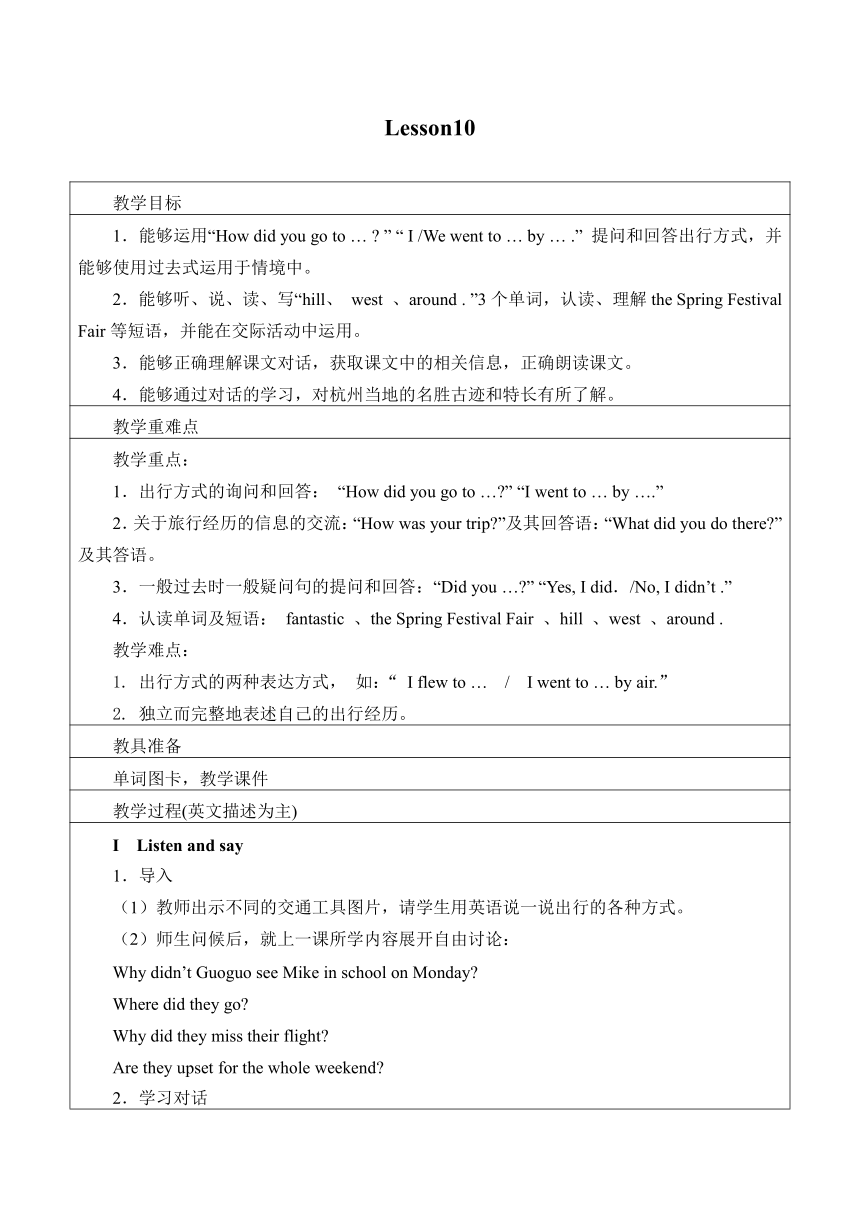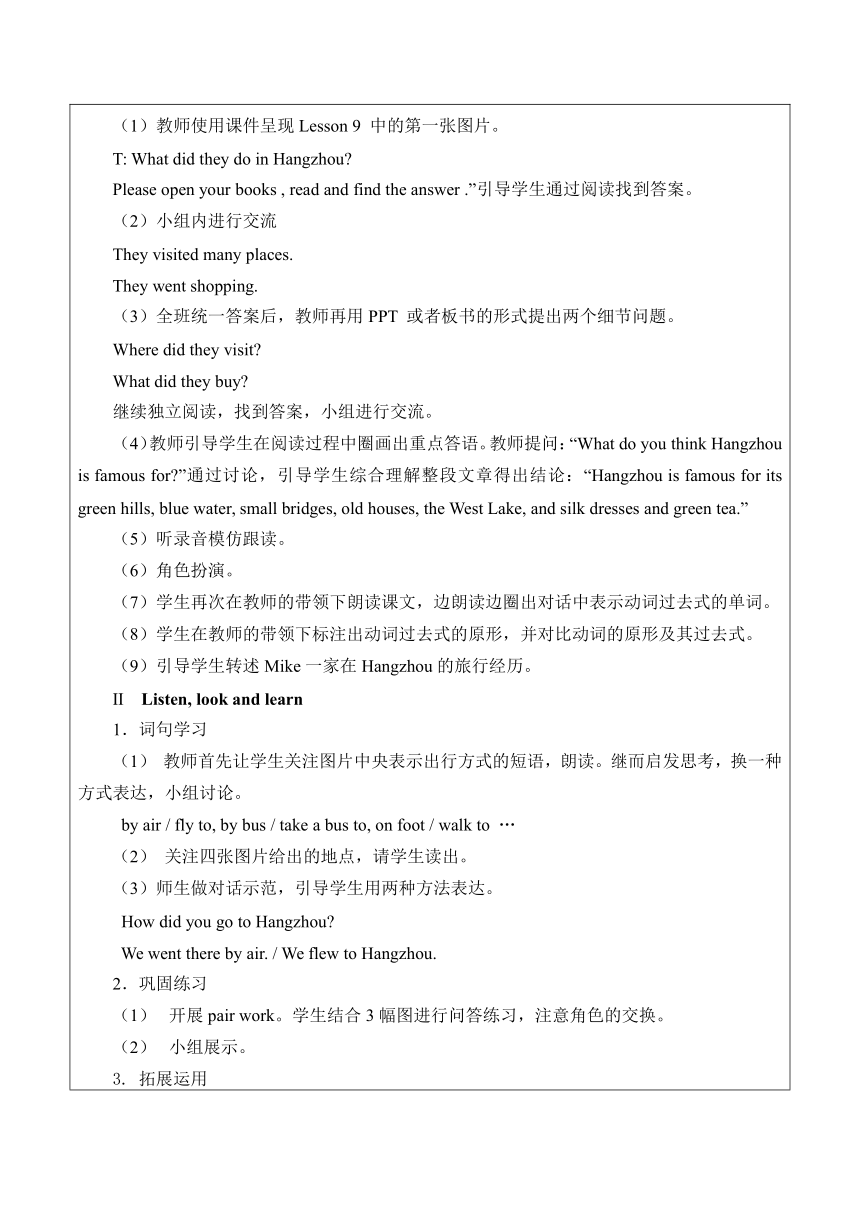Unit 3 How did you go to Hangzhou? Lesson 10 教案
文档属性
| 名称 | Unit 3 How did you go to Hangzhou? Lesson 10 教案 |  | |
| 格式 | zip | ||
| 文件大小 | 22.8KB | ||
| 资源类型 | 教案 | ||
| 版本资源 | 北京版 | ||
| 科目 | 英语 | ||
| 更新时间 | 2020-04-26 16:20:06 | ||
图片预览


文档简介
Lesson10
教学目标
1.能够运用“How did you go to … ? ” “ I /We went to … by … .” 提问和回答出行方式,并能够使用过去式运用于情境中。
2.能够听、说、读、写“hill、 west 、around . ”3个单词,认读、理解the Spring Festival Fair等短语,并能在交际活动中运用。
3.能够正确理解课文对话,获取课文中的相关信息,正确朗读课文。
4.能够通过对话的学习,对杭州当地的名胜古迹和特长有所了解。
教学重难点
教学重点:
1.出行方式的询问和回答: “How did you go to …?” “I went to … by ….”
2.关于旅行经历的信息的交流:“How was your trip?”及其回答语:“What did you do there?”及其答语。
3.一般过去时一般疑问句的提问和回答:“Did you …?” “Yes, I did./No, I didn’t .”
4.认读单词及短语: fantastic 、the Spring Festival Fair 、hill 、west 、around .
教学难点:
出行方式的两种表达方式, 如:“ I flew to … / I went to … by air.”
独立而完整地表述自己的出行经历。
教具准备
单词图卡,教学课件
教学过程(英文描述为主)
I Listen and say
1.导入
(1)教师出示不同的交通工具图片,请学生用英语说一说出行的各种方式。
(2)师生问候后,就上一课所学内容展开自由讨论:
Why didn’t Guoguo see Mike in school on Monday?
Where did they go?
Why did they miss their flight?
Are they upset for the whole weekend?
2.学习对话
(1)教师使用课件呈现Lesson 9 中的第一张图片。
T: What did they do in Hangzhou?
Please open your books , read and find the answer .”引导学生通过阅读找到答案。
(2)小组内进行交流
They visited many places.
They went shopping.
(3)全班统一答案后,教师再用PPT 或者板书的形式提出两个细节问题。
Where did they visit?
What did they buy?
继续独立阅读,找到答案,小组进行交流。
(4)教师引导学生在阅读过程中圈画出重点答语。教师提问:“What do you think Hangzhou is famous for?”通过讨论,引导学生综合理解整段文章得出结论:“Hangzhou is famous for its green hills, blue water, small bridges, old houses, the West Lake, and silk dresses and green tea.”
(5)听录音模仿跟读。
(6)角色扮演。
(7)学生再次在教师的带领下朗读课文,边朗读边圈出对话中表示动词过去式的单词。
(8)学生在教师的带领下标注出动词过去式的原形,并对比动词的原形及其过去式。
(9)引导学生转述Mike一家在Hangzhou的旅行经历。
II Listen, look and learn
1.词句学习
(1) 教师首先让学生关注图片中央表示出行方式的短语,朗读。继而启发思考,换一种方式表达,小组讨论。
by air / fly to, by bus / take a bus to, on foot / walk to …
(2) 关注四张图片给出的地点,请学生读出。
(3)师生做对话示范,引导学生用两种方法表达。
How did you go to Hangzhou?
We went there by air. / We flew to Hangzhou.
2.巩固练习
开展pair work。学生结合3幅图进行问答练习,注意角色的交换。
小组展示。
拓展运用
(1)小组内说说自己曾经有过的出行经历,尝试表达。
Last weekend I went to the zoo. I went there by bus. I saw a lot of animals there.
(2)组内交流。
(3)小组展示,评价表现。
III Listen and write
1.Have the children observe the pictures and talk about each picture with their partner.
2.Choose a child to describe what they can see in the pictures.
3.Play the tape twice and have them write down the words.
4.Have them listen again and check the answer in class.
IV Let’s do
1.师生共同阅读,看看如何完成该活动。
2.小组讨论,明确活动。
3.教师引导学生关注时态。
4.教师明确活动要求。
Discuss in groups, share your idea.
Finish it on your own.
Share in groups.
V Homework
1.朗读对话3遍,理解对话含义。
2.抄写文中的重点单词、短语、句子。
3.与同伴练习用功能句问答。
板书设计
U3 How did you go to Hangzhou? L10
see --- saw buy ---- bought
by air / fly to by bus / take a bus to by subway / take a subway to
by taxi / take a taxi to by train / take a train to on foot / walk to
How did you go to Hangzhou?
We went there by air. / We flew to Hangzhou.
学习效果评价设计
评价内容:
1.学生是否理解对话内容。
2.学生是否能够正确朗读对话,并体会故事中人物的思想感情。
3.学生是否能够运用主要句型进行造句。
4.学生的口语表达能力。
评价方式:
1.回答问题;
2.跟读对话并分角色朗读对话;
3.运用重点句型造句。
4.听力填空。
5.采访活动。
评价量规:
评价活动
评价方法
评价标准
回答问题
根据插图或文本回答问题。
一级:能理解内容,能熟练、准确地回答问题;
二级:对大概内容有所了解,能说出关键词。
读对话
1.跟读
2.在小组内分角色朗读对话
一级:能够理解人物感情,用恰当的语气和语调读出对话;
二级:能够比较准确地朗读对话。
听力
听力填空
一级:能理解所听内容,并能根据内容正确地完成相关练习。
二级:能基本理解所听内容的大意, 能根据内容较好地完成相关练习。
句型掌握
造句
一级:能够运用重点句型,正确造句。
二级:能够根据图片模仿例句造句。
采访活动
采访并正确填写表格
一级:能够灵活运用相关话题句型进行交际,并正确填写表格。
二级:能够运用基本句型进行交际,并填写表格。
教学目标
1.能够运用“How did you go to … ? ” “ I /We went to … by … .” 提问和回答出行方式,并能够使用过去式运用于情境中。
2.能够听、说、读、写“hill、 west 、around . ”3个单词,认读、理解the Spring Festival Fair等短语,并能在交际活动中运用。
3.能够正确理解课文对话,获取课文中的相关信息,正确朗读课文。
4.能够通过对话的学习,对杭州当地的名胜古迹和特长有所了解。
教学重难点
教学重点:
1.出行方式的询问和回答: “How did you go to …?” “I went to … by ….”
2.关于旅行经历的信息的交流:“How was your trip?”及其回答语:“What did you do there?”及其答语。
3.一般过去时一般疑问句的提问和回答:“Did you …?” “Yes, I did./No, I didn’t .”
4.认读单词及短语: fantastic 、the Spring Festival Fair 、hill 、west 、around .
教学难点:
出行方式的两种表达方式, 如:“ I flew to … / I went to … by air.”
独立而完整地表述自己的出行经历。
教具准备
单词图卡,教学课件
教学过程(英文描述为主)
I Listen and say
1.导入
(1)教师出示不同的交通工具图片,请学生用英语说一说出行的各种方式。
(2)师生问候后,就上一课所学内容展开自由讨论:
Why didn’t Guoguo see Mike in school on Monday?
Where did they go?
Why did they miss their flight?
Are they upset for the whole weekend?
2.学习对话
(1)教师使用课件呈现Lesson 9 中的第一张图片。
T: What did they do in Hangzhou?
Please open your books , read and find the answer .”引导学生通过阅读找到答案。
(2)小组内进行交流
They visited many places.
They went shopping.
(3)全班统一答案后,教师再用PPT 或者板书的形式提出两个细节问题。
Where did they visit?
What did they buy?
继续独立阅读,找到答案,小组进行交流。
(4)教师引导学生在阅读过程中圈画出重点答语。教师提问:“What do you think Hangzhou is famous for?”通过讨论,引导学生综合理解整段文章得出结论:“Hangzhou is famous for its green hills, blue water, small bridges, old houses, the West Lake, and silk dresses and green tea.”
(5)听录音模仿跟读。
(6)角色扮演。
(7)学生再次在教师的带领下朗读课文,边朗读边圈出对话中表示动词过去式的单词。
(8)学生在教师的带领下标注出动词过去式的原形,并对比动词的原形及其过去式。
(9)引导学生转述Mike一家在Hangzhou的旅行经历。
II Listen, look and learn
1.词句学习
(1) 教师首先让学生关注图片中央表示出行方式的短语,朗读。继而启发思考,换一种方式表达,小组讨论。
by air / fly to, by bus / take a bus to, on foot / walk to …
(2) 关注四张图片给出的地点,请学生读出。
(3)师生做对话示范,引导学生用两种方法表达。
How did you go to Hangzhou?
We went there by air. / We flew to Hangzhou.
2.巩固练习
开展pair work。学生结合3幅图进行问答练习,注意角色的交换。
小组展示。
拓展运用
(1)小组内说说自己曾经有过的出行经历,尝试表达。
Last weekend I went to the zoo. I went there by bus. I saw a lot of animals there.
(2)组内交流。
(3)小组展示,评价表现。
III Listen and write
1.Have the children observe the pictures and talk about each picture with their partner.
2.Choose a child to describe what they can see in the pictures.
3.Play the tape twice and have them write down the words.
4.Have them listen again and check the answer in class.
IV Let’s do
1.师生共同阅读,看看如何完成该活动。
2.小组讨论,明确活动。
3.教师引导学生关注时态。
4.教师明确活动要求。
Discuss in groups, share your idea.
Finish it on your own.
Share in groups.
V Homework
1.朗读对话3遍,理解对话含义。
2.抄写文中的重点单词、短语、句子。
3.与同伴练习用功能句问答。
板书设计
U3 How did you go to Hangzhou? L10
see --- saw buy ---- bought
by air / fly to by bus / take a bus to by subway / take a subway to
by taxi / take a taxi to by train / take a train to on foot / walk to
How did you go to Hangzhou?
We went there by air. / We flew to Hangzhou.
学习效果评价设计
评价内容:
1.学生是否理解对话内容。
2.学生是否能够正确朗读对话,并体会故事中人物的思想感情。
3.学生是否能够运用主要句型进行造句。
4.学生的口语表达能力。
评价方式:
1.回答问题;
2.跟读对话并分角色朗读对话;
3.运用重点句型造句。
4.听力填空。
5.采访活动。
评价量规:
评价活动
评价方法
评价标准
回答问题
根据插图或文本回答问题。
一级:能理解内容,能熟练、准确地回答问题;
二级:对大概内容有所了解,能说出关键词。
读对话
1.跟读
2.在小组内分角色朗读对话
一级:能够理解人物感情,用恰当的语气和语调读出对话;
二级:能够比较准确地朗读对话。
听力
听力填空
一级:能理解所听内容,并能根据内容正确地完成相关练习。
二级:能基本理解所听内容的大意, 能根据内容较好地完成相关练习。
句型掌握
造句
一级:能够运用重点句型,正确造句。
二级:能够根据图片模仿例句造句。
采访活动
采访并正确填写表格
一级:能够灵活运用相关话题句型进行交际,并正确填写表格。
二级:能够运用基本句型进行交际,并填写表格。
同课章节目录
- Unit 1 What did you do this summer?
- Lesson 1
- Lesson 2
- Lesson 3
- Lesson 4
- Unit 2 What happened to your neck?
- Lesson 5
- Lesson 6
- Lesson 7
- Lesson 8
- Unit 3 How did you go to Hangzhou?
- Lesson 9
- Lesson 10
- Lesson 11
- Lesson 12
- Unit 4 Revision
- Lesson 13
- Lesson 14
- Unit 5 When did the ancient Olympic Games begin?
- Lesson 15
- Lesson 16
- Lesson 17
- Lesson 18
- Unit 6 What is he wearing?
- Lesson 19
- Lesson 20
- Lesson 21
- Lesson 22
- Unit 7 What are the twelve animals?
- Lesson 23
- Lesson 24
- Lesson 25
- Lesson 26
- Unit 8 Revision
- Lesson 27
- Lesson 28
